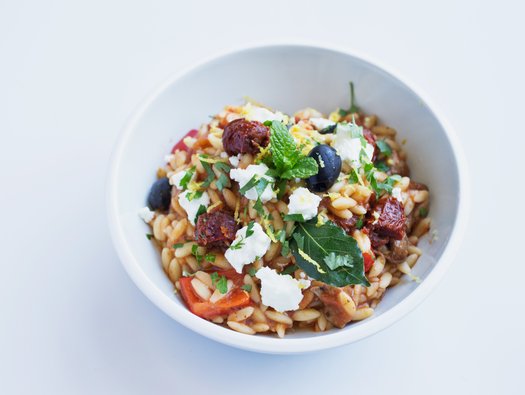Greek lamb with orzo

Prepare this one-pot meal in advance for a tasty post-dialysis meal that’s high in protein and low in potassium and phosphate.

Prepare this one-pot meal in advance for a tasty post-dialysis meal that’s high in protein and low in potassium and phosphate.
1 tablespoon olive oil
800g diced lamb shoulder
2 onions
1 teaspoon oregano, dried
1 teaspoon thyme, dried
1 teaspoon mint, dried
3 bay leaves
½ teaspoon ground cumin
1 teaspoon smoked paprika
600ml low salt chicken stock
300g orzo pasta
400g tinned tomatoes
1 red pepper (approx. 75g)
75g pitted black olives
50g sun dried tomatoes
100g feta cheese
1 lemon
Fresh oregano, mint and thyme (optional)
Heat the oven to 180°C / gas mark 4. Season the lamb well with pepper and the dried thyme, oregano and mint. Heat the oil in a large casserole dish over a high heat. Fry for 5 minutes until browned on all sides.
Finely chop and stir in the onions, bay leaves, cumin and paprika. Add the tinned tomatoes and 350ml of the hot chicken stock. Stir well and bring to a simmer. Cover the casserole dish and transfer to the oven to cook for 1 ½ hours – until the lamb is tender.
Deseed and chop the pepper and dice the sun dried tomatoes, stirring them in with the olives, orzo and remaining stock. Stir well and recover with the lid. Return to the oven for a further 30 minutes until the orzo is tender.
Remove from the oven, stir well and crumble over the feta cheese and sprinkle over some freshly cut herbs if desired. Add the zest of one lemon and drizzle over the juice to serve.
The main source of carbohydrate in this dish comes from the orzo. The carbohydrate value of this dish has been provided for those who have been trained in insulin adjustment.
This dish does contain ingredients that are high in potassium and phosphate, such as tomatoes, sun dried tomatoes and cheese. However, the quantities have been kept to a minimum and by using the quantities listed and following the the recommended serving size, the overall phosphate and potassium content of the dish remains low.
If you have been prescribed a phosphate binder ensure you take them with this dish.
This is a great high protein dish, ideal for those on dialysis. If you have been advised to reduce your protein intake, enjoy a smaller portion or consider substituting the lamb for a vegetarian alternative such as tofu, chickpeas or butter beans.
Use a gluten free stock and switch to a gluten free pasta. Macaroni would work well if you can’t find gluten free orzo.
Use tofu, chickpeas or butter beans and reduce cooking time to 30 minutes.
Use a vegan Greek-style cheese.
The flavour of this dish comes from all the herbs and spices and therefore additional salt is not required. The stock will contain some salt but low salt or very low salt stock cubes or stockpots are readily available in supermarkets.
Lamb can be quite an expensive meat. Chicken or pork could be used or try the vegetarian option for a cheaper alternative. If fresh herbs are not available you can used dried herbs.
Allow any leftovers to cool, then refrigerate and consume within two days. If freezing, place in a sealed container in portions. Defrost and reheat thoroughly before serving.
By giving us your email address, you're giving us permission to send you the latest news from Kidney Care UK. Further information about how we protect and use your personal data is available in our Privacy policy. If you would like to change the way we communicate with you at any time please email [email protected]. You can unsubscribe at any time by using the link at the bottom of every email we send.